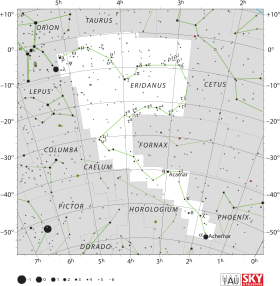15 Eridani
| Ascension droite | 03h 18m 22,105s[1] |
|---|---|
| Déclinaison | −22° 30′ 40,02″[1] |
| Constellation | Éridan |
| Magnitude apparente |
4,875 (6,57 / 5,32)[2],[3] |
Localisation dans la constellation : Éridan | |
| Stade évolutif | red clump |
|---|---|
| Type spectral | K0III[4] |
| Indice B-V | +0,90[5] |
| Vitesse radiale | +23,90 ± 0,5 km/s[6] |
|---|---|
| Mouvement propre |
μα = +13,08 mas/a[1] μδ = +13,33 mas/a[1] |
| Parallaxe | 12,77 ± 1,17 mas[1] |
| Distance |
260 ± 20 al (78 ± 7 pc) |
| Magnitude absolue | +0,85[7] |
| Masse | 2,32 M☉[8] |
|---|---|
| Luminosité | 72,4 L☉[8] |
| Température | 4 960 ± 31 K[8] |
| Rotation | 4,5 ± 0,2 km/s[7] |
| Âge | 1,44 Ga[8] |
| Composants stellaires | 15 Eri A, 15 Eri B |
|---|
| Compagnon | 15 Eri B[3] |
|---|---|
| Demi-grand axe (a) | 0,340 ″ |
| Excentricité (e) | 0,030 |
| Période (P) | 118,16 a |
| Inclinaison (i) | 66,6° |
| Argument du périastre (ω) | 333,5° |
| Époque du périastre (τ) | 1 934,24 a |
Désignations
15 Eridani (en abrégé 15 Eri) est une étoile binaire de la constellation de l'Éridan. Elle est visible à l'œil nu avec une magnitude apparente combinée de 4,88[2]. D'après la mesure de sa parallaxe annuelle par le satellite Hipparcos, le système est distant d'approximativement ∼ 260 a.l. (∼ 79,7 pc) de la Terre[1]. Il s'éloigne du Système solaire à une vitesse radiale héliocentrique de +24 km/s[6].
15 Eridani est une étoile binaire visuelle proche avec une période orbitale de 118,16 ans, une excentricité très faible de 0,03 et un demi-grand axe de 0,34 seconde d'arc[3]. Sa composante primaire, désignée 15 Eridani A, est une étoile géante rouge de magnitude 5,32[10] et de type spectral K0 III[4]. C'est une géante du red clump[11], ce qui signifie qu'elle est située à l'extrémité rouge de la branche horizontale et qu'elle génère son énergie par la fusion de l'hélium dans son noyau. L'étoile est estimée être âgée de 1,44 milliard d'années elle est 2,32 fois plus massive que le Soleil. Elle est 72,4 fois plus lumineuse que le Soleil et sa température de surface est de 4 960 K[8]. Son compagnon, 15 Eridani B, est une étoile de magnitude 6,57[10].
Notes et références
- (en) Cet article est partiellement ou en totalité issu de l’article de Wikipédia en anglais intitulé « 15 Eridani » (voir la liste des auteurs).
- (en) F. van Leeuwen, « Validation of the new Hipparcos reduction », Astronomy & Astrophysics, vol. 474, no 2, , p. 653–664 (DOI 10.1051/0004-6361:20078357, Bibcode 2007A&A...474..653V, arXiv 0708.1752)
- (en) E. Høg et al., « The Tycho-2 catalogue of the 2.5 million brightest stars », Astronomy & Astrophysics, vol. 355, , L27-L30 (DOI 10.1888/0333750888/2862, Bibcode 2000A&A...355L..27H)
- (en) « Sixth Catalog of Orbits of Visual Binary Stars » [archive du ], United States Naval Observatory (consulté le )
- (en) Nancy Houk et M. Smith-Moore, Michigan Catalogue of Two-dimensional Spectral Types for the HD Stars : Declinations -26° to -12°, vol. 4, Ann Arbor, Michigan, États-Unis, Département d'astronomie de l'université du Michigan, , 14+505 (Bibcode 1988mcts.book.....H)
- ↑ (en) H. L. Johnson et al., « UBVRIJKL photometry of the bright stars », Communications of the Lunar and Planetary Laboratory, vol. 4, no 99, (Bibcode 1966CoLPL...4...99J)
- (en) N. V. Kharchenko et al., « Astrophysical supplements to the ASCC-2.5: Ia. Radial velocities of ∼55000 stars and mean radial velocities of 516 Galactic open clusters and associations », Astronomische Nachrichten, vol. 328, no 9, , p. 889 (DOI 10.1002/asna.200710776, Bibcode 2007AN....328..889K, arXiv 0705.0878)
- (en) Matthias Ammler-von Eiff et Ansgar Reiners, « New measurements of rotation and differential rotation in A-F stars: are there two populations of differentially rotating stars? », Astronomy & Astrophysics, vol. 542, , A116 (DOI 10.1051/0004-6361/201118724, Bibcode 2012A&A...542A.116A, arXiv 1204.2459)
- (en) R. Earle Luck, « Abundances in the Local Region. I. G and K Giants », The Astronomical Journal, vol. 150, no 3, , p. 88 (DOI 10.1088/0004-6256/150/3/88, Bibcode 2015AJ....150...88L, arXiv 1507.01466)
- ↑ (en) * 15 Eri -- Double or Multiple Star sur la base de données Simbad du Centre de données astronomiques de Strasbourg.
- (en) P. P. Eggleton et A. A. Tokovinin, « A catalogue of multiplicity among bright stellar systems », Monthly Notices of the Royal Astronomical Society, vol. 389, no 2, , p. 869–879 (DOI 10.1111/j.1365-2966.2008.13596.x, Bibcode 2008MNRAS.389..869E, arXiv 0806.2878)
- ↑ (en) David R. Alves, « K-Band Calibration of the Red Clump Luminosity », The Astrophysical Journal, vol. 539, no 2, , p. 732–741 (DOI 10.1086/309278, Bibcode 2000ApJ...539..732A, arXiv astro-ph/0003329)
Liens externes
- (en) 15 Eridani sur la base de données Simbad du Centre de données astronomiques de Strasbourg.
